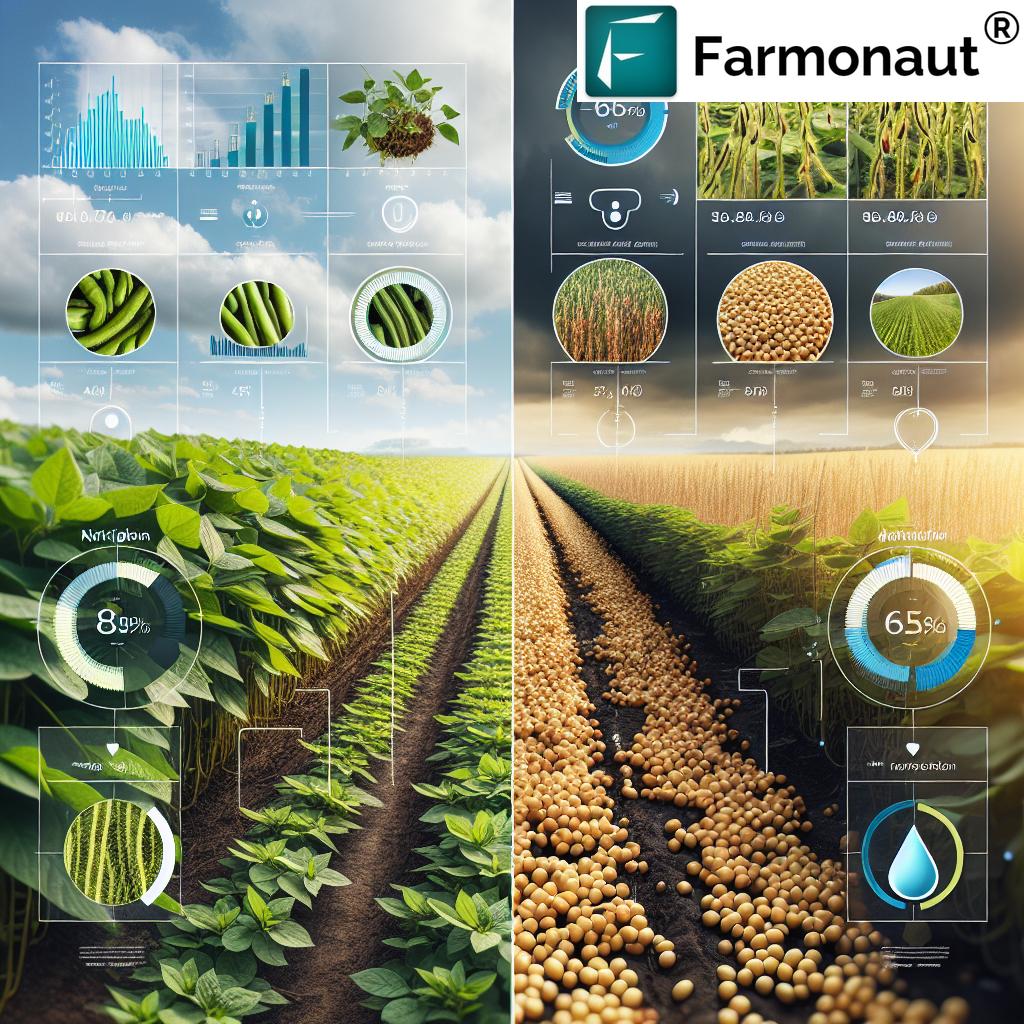Maximizing Soybean Yields: Farmonaut’s Guide to Nitrogen and Sulfur Management in Iowa
“Soybean nutrient uptake peaks during R2 to R5 growth stages, with 8 varieties studied across 3 locations over 2 years.”
Welcome to Farmonaut’s comprehensive guide on maximizing soybean yields through effective nitrogen and sulfur management in Iowa. As leaders in agricultural technology, we’re excited to share groundbreaking insights that challenge previous assumptions and provide you with cutting-edge strategies to optimize your soybean production.
In this blog post, we’ll delve into the intricacies of soybean nitrogen uptake and explore the crucial role of sulfur in soybean production. Our analysis is based on a rigorous two-year study conducted across three locations, examining eight soybean varieties. This research has unveiled key findings that will revolutionize your approach to nutrient management for high yield soybeans.
The Importance of Nitrogen and Sulfur in Soybean Production
Nitrogen and sulfur are essential nutrients for soybean growth and development. Understanding their dynamics throughout the growing season is crucial for optimizing yields and ensuring sustainable production practices. Let’s explore why these nutrients are so vital:
- Nitrogen: As a key component of amino acids, proteins, and chlorophyll, nitrogen plays a critical role in soybean growth, photosynthesis, and yield potential.
- Sulfur: This nutrient is essential for protein synthesis, chlorophyll formation, and overall plant health. It’s particularly important for nitrogen fixation in legumes like soybeans.
Our research has revealed fascinating insights into how soybeans utilize these nutrients, challenging some long-held beliefs in the process.
Groundbreaking Findings on Soybean Nutrient Requirements
One of the most surprising outcomes of our study is the revelation that high-yielding soybean crops often achieve sufficient nitrogen through biological fixation and soil organic matter. This finding challenges the conventional wisdom that additional nitrogen fertilization is always necessary for maximizing yields.
“High-yielding soybean crops often achieve sufficient nitrogen through biological fixation and soil organic matter, challenging previous assumptions.”
Key takeaways from our research include:
- Nutrient uptake peaks during the R2 to R5 growth stages
- The importance of soil health and organic matter in sustainable soybean production
- The critical role of timing in nutrient management strategies
These insights provide a foundation for developing more effective and environmentally friendly soybean management practices.
Understanding Soybean Growth Stages and Nutrient Uptake
To fully grasp the nutrient dynamics in soybean production, it’s essential to understand the various growth stages and how they relate to nutrient uptake. Let’s break down the key stages and their nutrient requirements:
| Growth Stage | Estimated Nitrogen Uptake (lbs/acre) | Estimated Sulfur Uptake (lbs/acre) | Management Recommendations |
|---|---|---|---|
| VE (Emergence) | 5-10 | 0.5-1 | Ensure good soil-to-seed contact; monitor for early-season pests |
| V1-V3 (Early Vegetative) | 15-30 | 1-2 | Scout for weeds; consider early-season herbicide application |
| V4-V6 (Mid Vegetative) | 40-60 | 3-5 | Monitor for nutrient deficiencies; apply foliar nutrients if needed |
| R1 (Beginning Bloom) | 70-90 | 6-8 | Ensure adequate soil moisture; scout for flowering pests |
| R2-R3 (Full Bloom – Beginning Pod) | 100-150 | 10-15 | Critical stage for nutrient uptake; ensure optimal soil conditions |
| R4-R5 (Full Pod – Beginning Seed) | 200-250 | 18-22 | Peak nutrient demand; monitor for pod-filling stresses |
| R6-R7 (Full Seed – Beginning Maturity) | 275-300 | 25-30 | Maintain soil moisture; prepare for harvest |
| R8 (Full Maturity) | 300-320 | 30-35 | Monitor grain moisture; harvest at optimal timing |
As we can see from this table, nutrient uptake intensifies significantly during the reproductive stages, particularly from R2 to R5. This information is crucial for timing your management practices to support optimal soybean growth and development.
The Role of Biological Nitrogen Fixation in Soybeans
Biological nitrogen fixation is a remarkable process that allows soybeans to meet a significant portion of their nitrogen needs. This process occurs through a symbiotic relationship between soybeans and rhizobia bacteria in root nodules. Our research has shed new light on the efficiency of this process in high-yielding soybean crops.
Key findings on biological nitrogen fixation include:
- High-yielding soybeans can fix up to 300 lbs of nitrogen per acre
- Effective nodulation can reduce or eliminate the need for supplemental nitrogen fertilization
- Soil conditions, pH, and the presence of native rhizobia populations influence fixation efficiency
Understanding and optimizing biological nitrogen fixation can lead to significant cost savings and environmental benefits in soybean production.
The Importance of Sulfur in Soybean Nutrition
While nitrogen often takes center stage in nutrient management discussions, our research highlights the critical role of sulfur in soybean production. Sulfur is essential for various physiological processes and can significantly impact yield potential.
Key insights on sulfur management include:
- Sulfur uptake patterns closely mirror those of nitrogen
- Deficiencies can lead to reduced nitrogen fixation and overall yield loss
- Soil testing and tissue analysis are crucial for identifying and addressing sulfur deficiencies
Incorporating sulfur management into your overall nutrient strategy is essential for maximizing soybean yields and quality.
Optimizing Nutrient Management with Farmonaut’s Agtech Tools
At Farmonaut, we’re committed to helping growers apply these research findings effectively in the field. Our advanced agtech tools can revolutionize your approach to nutrient management and crop monitoring.
Here’s how Farmonaut can help you optimize your soybean production:
- Real-time Crop Health Monitoring: Our satellite-based monitoring system provides up-to-date information on crop health, allowing you to identify potential nutrient deficiencies early.
- AI-powered Advisory System: Receive personalized recommendations for nutrient management based on your specific field conditions and crop stage.
- Precision Application Tools: Optimize your nutrient applications with our advanced mapping and variable rate application technologies.
By leveraging Farmonaut’s cutting-edge technology, you can make data-driven decisions that maximize your soybean yields while promoting sustainable farming practices.
Enhancing Soil Health for Sustainable Soybean Production
Our research underscores the importance of soil health in achieving optimal soybean yields. Healthy soils with high organic matter content provide numerous benefits, including:
- Improved nutrient retention and availability
- Enhanced water-holding capacity
- Increased biological activity, supporting nutrient cycling
- Greater resilience to environmental stresses
To enhance soil health and organic matter content, consider implementing the following practices:
- Cover Cropping: Plant cover crops during fallow periods to add organic matter and prevent erosion.
- Reduced Tillage: Minimize soil disturbance to preserve soil structure and organic matter.
- Crop Rotation: Diversify your crop rotation to improve soil health and break pest cycles.
- Compost and Manure Application: Incorporate organic amendments to boost soil organic matter and nutrient content.
By focusing on soil health, you’re laying the foundation for sustainable, high-yielding soybean production for years to come.
Precision Nutrient Management Strategies
Armed with our research findings and Farmonaut’s advanced tools, you can implement precision nutrient management strategies that maximize efficiency and yield potential. Here are some key approaches to consider:
- Variable Rate Application: Use soil testing and yield mapping to apply nutrients at varying rates across your field, matching application to specific areas of need.
- In-Season Monitoring: Regularly assess crop health and nutrient status throughout the growing season, making adjustments as needed.
- Foliar Applications: Consider targeted foliar applications of nutrients during critical growth stages to address deficiencies quickly.
- Timing Optimization: Align nutrient applications with peak uptake periods, focusing on the R2 to R5 growth stages.
By implementing these strategies, you can ensure that your soybean crop receives the right nutrients, in the right amount, at the right time, and in the right place.

Environmental Stewardship in Soybean Production
As we strive for higher yields, it’s crucial to maintain a focus on environmental stewardship. Our research findings support sustainable practices that can reduce environmental impact while maintaining productivity. Consider the following approaches:
- Optimized Fertilizer Use: By leveraging biological nitrogen fixation and precise nutrient management, you can reduce overall fertilizer inputs.
- Reduced Nutrient Runoff: Implementing conservation practices like buffer strips and cover crops can minimize nutrient loss to waterways.
- Carbon Sequestration: Practices that enhance soil health also contribute to carbon sequestration, helping mitigate climate change.
- Integrated Pest Management: Use Farmonaut’s monitoring tools to implement targeted pest control strategies, reducing pesticide use.
By adopting these environmentally conscious practices, you’re not only protecting natural resources but also potentially accessing new markets and premiums for sustainably produced soybeans.
Adapting to Climate Variability in Iowa
Climate variability poses significant challenges to soybean production in Iowa. Our research, conducted across multiple environments, provides insights into managing nutrients under varying conditions. Here are some strategies to enhance resilience:
- Drought Tolerance: Focus on building soil organic matter to improve water retention capacity.
- Excess Moisture: Implement drainage systems and consider raised bed planting in flood-prone areas.
- Temperature Extremes: Use Farmonaut’s weather forecasting tools to time planting and management activities optimally.
- Variety Selection: Choose soybean varieties adapted to local conditions and potential climate stresses.
By preparing for climate variability, you can maintain consistent yields even in challenging growing seasons.
Leveraging Data for Continuous Improvement
One of the most powerful aspects of modern agriculture is the ability to collect and analyze vast amounts of data. Farmonaut’s platform enables you to harness this potential for continuous improvement in your soybean production. Here’s how:
- Yield Mapping: Analyze yield variability across your fields to identify areas for improvement.
- Historical Trend Analysis: Track nutrient use efficiency and yield trends over time to refine your management strategies.
- Benchmarking: Compare your performance against regional averages to set realistic goals for improvement.
- Predictive Modeling: Use AI-powered tools to forecast potential yields and nutrient needs based on current conditions.
By embracing a data-driven approach, you can make informed decisions that lead to consistent yield improvements and resource use efficiency.
Economic Considerations in Nutrient Management
While our focus has been on agronomic aspects of soybean production, it’s crucial to consider the economic implications of nutrient management strategies. Here are some key economic factors to keep in mind:
- Return on Investment (ROI): Calculate the potential yield increase from nutrient applications against the cost of inputs.
- Variable Rate Economics: Assess the cost-effectiveness of precision application technologies in your operation.
- Long-term Soil Health: Consider the long-term economic benefits of investing in soil health and organic matter buildup.
- Risk Management: Use Farmonaut’s tools to minimize the risk of over- or under-applying nutrients, optimizing your input costs.
By carefully considering these economic factors, you can develop a nutrient management strategy that not only maximizes yields but also enhances your farm’s profitability and sustainability.
Integrating Farmonaut’s Tools into Your Soybean Management Plan
To help you put these insights into practice, let’s explore how you can integrate Farmonaut’s advanced tools into your soybean management plan:
- Satellite Monitoring: Use our satellite-based crop health monitoring to track NDVI and other vegetation indices throughout the growing season.
- AI Advisory System: Leverage our Jeevn AI system for personalized recommendations on nutrient management and other agronomic practices.
- Weather Forecasting: Utilize our accurate weather predictions to time your planting, nutrient applications, and other field operations optimally.
- Data Integration: Connect your field data with our platform to generate comprehensive insights and reports on your soybean crop performance.
By fully utilizing Farmonaut’s suite of tools, you can take your soybean production to the next level, maximizing yields while optimizing resource use.

Conclusion: Embracing the Future of Soybean Production
As we conclude this comprehensive guide to maximizing soybean yields through effective nitrogen and sulfur management in Iowa, it’s clear that the future of soybean production is bright. By combining cutting-edge research insights with advanced agricultural technology, we can achieve unprecedented levels of productivity and sustainability.
Key takeaways from our discussion include:
- The critical importance of understanding soybean nutrient uptake patterns, especially during peak demand stages
- The potential for high-yielding soybeans to meet nitrogen needs through biological fixation and soil organic matter
- The crucial role of sulfur in supporting optimal soybean growth and yield
- The value of precision nutrient management strategies in maximizing efficiency and environmental stewardship
- The power of data-driven decision-making in continually improving soybean production practices
By implementing these insights and leveraging Farmonaut’s advanced agtech tools, you’re well-positioned to take your soybean production to new heights. Remember, sustainable high yields are not just about applying more inputs, but about applying them smarter.
We invite you to explore Farmonaut’s comprehensive suite of tools and services to support your journey towards optimal soybean production. Whether you’re looking to enhance your nutrient management, improve crop monitoring, or gain deeper insights into your field’s performance, we’re here to help you every step of the way.
Ready to revolutionize your soybean management approach? Get started with Farmonaut today!
For developers interested in integrating our powerful agricultural data into their own applications, check out our API and API Developer Docs.
Frequently Asked Questions (FAQ)
Q1: How does biological nitrogen fixation work in soybeans?
A1: Biological nitrogen fixation in soybeans occurs through a symbiotic relationship with rhizobia bacteria in root nodules. These bacteria convert atmospheric nitrogen into a form the plant can use, reducing or eliminating the need for supplemental nitrogen fertilizer.
Q2: What are the key growth stages for nutrient uptake in soybeans?
A2: Nutrient uptake in soybeans peaks during the R2 to R5 growth stages, which correspond to full bloom through beginning seed development. It’s crucial to ensure adequate nutrient availability during these stages.
Q3: How can I determine if my soybeans are sulfur deficient?
A3: Sulfur deficiency symptoms include yellowing of younger leaves, stunted growth, and reduced nodulation. Soil testing and tissue analysis are the most reliable methods for confirming sulfur deficiency.
Q4: Can high-yielding soybeans really meet their nitrogen needs without fertilization?
A4: Yes, our research shows that high-yielding soybeans can often meet their nitrogen needs through a combination of biological fixation and nitrogen mineralization from soil organic matter, challenging the need for routine nitrogen fertilization.
Q5: How can Farmonaut’s tools help me optimize my soybean nutrient management?
A5: Farmonaut offers satellite-based crop monitoring, AI-powered advisory systems, and precision application tools that can help you track crop health, identify nutrient deficiencies early, and apply nutrients more efficiently based on specific field conditions.
















